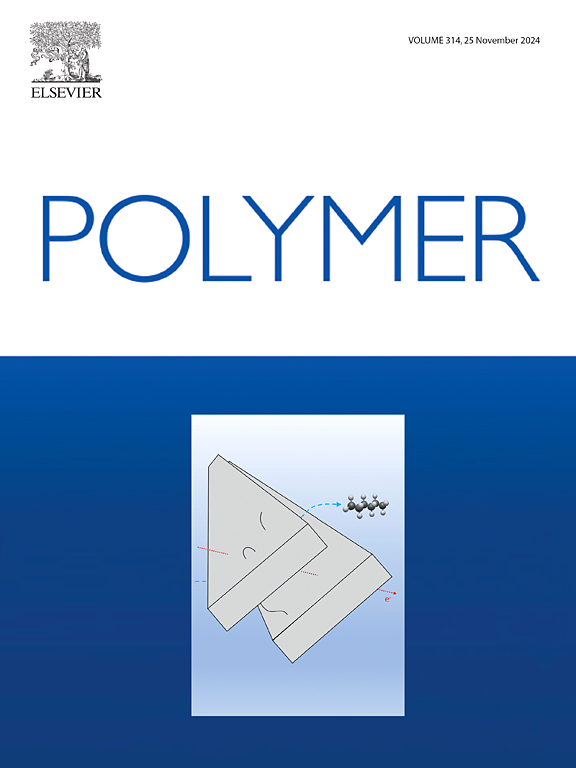聚吡咯甲烷改性三聚氰胺海绵三维可回收吸附剂的制备
IF 4.5
2区 化学
Q2 POLYMER SCIENCE
引用次数: 0
摘要
粉末型聚吡咯(PPy)吸附剂的吸附活性不足,固液分离性能差,限制了其实际应用。因此,合成聚吡咯甲烷作为聚吡咯的衍生物,并将其加载到三聚氰胺海绵上,构建三维聚合物吸附剂(MS@PPm),可以同时解决传统聚吡咯吸附剂的两个缺陷。所得MS@PPm含有丰富的含N和含o位点,有利于Cr(VI)的去除。静态间歇实验结果表明,在较低的pH值下,MS@PPm对Cr(VI)的去除是有益的。吸附过程符合准二级动力学模型,表明Cr(VI)是通过化学吸附吸附到MS@PPm上的。MS@PPm的饱和吸附容量达到320.56 mg·g-1,优于文献中大多数pp基吸附剂和其他吸附剂。MS@PPm对共存阴离子的Cr(VI)吸附也有显著的特异性。循环5次后,去除率仍超过82.43%,具有良好的再生利用性能。通过MS@PPm可以连续去除Cr(VI),在100 h的连续动态柱实验中,Cr(VI)的去除率超过90%。吸附机理研究表明,Cr(VI)不仅可以通过静电吸引和离子交换作用吸附在MS@PPm上,还可以转化为无害的Cr(III)并在吸附剂上络合。本研究表明MS@PPm对水体中Cr(VI)具有很大的修复潜力。本文章由计算机程序翻译,如有差异,请以英文原文为准。


Facile preparation of poly(pyrrole methane) modified melamine sponge as 3D recyclable adsorbent for Cr(VI) removal
The insufficient adsorption activity and poor solid-liquid separation performance limit the practical application of powder polypyrrole (PPy)-based adsorbents. Thus, poly(pyrrole methane), a PPy derivative, was synthesized and loaded onto melamine sponge to construct a 3D polymer adsorbent (MS@PPm), which could simultaneously address the two defects of traditional PPy adsorbents. The obtained MS@PPm contained abundant N- and O-containing sites, which were beneficial for Cr(VI) removal. The results in static batch experiments demonstrated that the elimination of Cr(VI) by MS@PPm was beneficial with lower pH values. The adsorption process agreed with pseudo-second-order kinetic model, implying that Cr(VI) was adsorbed onto MS@PPm by chemisorption. The saturated adsorption capacity of MS@PPm achieved 320.56 mg g−1, which was superior than that of most PPy-based and other adsorbents in literatures. MS@PPm also showed prominent specificity for Cr(VI) adsorption even with coexisting anions. The removal rate still exceeded 82.43 % after 5 cycles, exhibiting an excellent regeneration and utilization performance. Moreover, Cr(VI) can be continuously removed by MS@PPm, and the removal efficiency exceeded 90 % in the 100 h continuous dynamic column experiments. The adsorption mechanism study revealed that Cr(VI) can not only be adsorbed onto MS@PPm by electrostatic attraction and ion-exchanging interactions, but also can be transformed to harmfulless Cr(III) and complexed on adsorbent. This study implied that MS@PPm had great potential for Cr(VI) remediation in water.
求助全文
通过发布文献求助,成功后即可免费获取论文全文。
去求助
来源期刊

Polymer
化学-高分子科学
CiteScore
7.90
自引率
8.70%
发文量
959
审稿时长
32 days
期刊介绍:
Polymer is an interdisciplinary journal dedicated to publishing innovative and significant advances in Polymer Physics, Chemistry and Technology. We welcome submissions on polymer hybrids, nanocomposites, characterisation and self-assembly. Polymer also publishes work on the technological application of polymers in energy and optoelectronics.
The main scope is covered but not limited to the following core areas:
Polymer Materials
Nanocomposites and hybrid nanomaterials
Polymer blends, films, fibres, networks and porous materials
Physical Characterization
Characterisation, modelling and simulation* of molecular and materials properties in bulk, solution, and thin films
Polymer Engineering
Advanced multiscale processing methods
Polymer Synthesis, Modification and Self-assembly
Including designer polymer architectures, mechanisms and kinetics, and supramolecular polymerization
Technological Applications
Polymers for energy generation and storage
Polymer membranes for separation technology
Polymers for opto- and microelectronics.
 求助内容:
求助内容: 应助结果提醒方式:
应助结果提醒方式:


